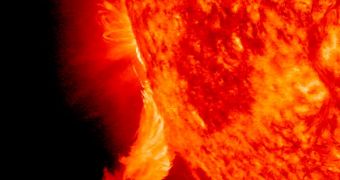Scientists gathered at a workshop held on June 21 in Washington DC agreed that Earth needs a unified approach to defending against the effects of potentially-devastating solar flares. The experts called into view the September 1859 flare that caused widespread damage.
At the time, the solar storm that struck Earth was one of the most intense in recorded history. Charged particles released by the Sun moved through the magnetosphere, and produced shimmering northern lights that were visible as far south as Cuba and Hawaii.
Telegraph networks were overwhelmed with the surge of electricity, and countless fires were started. Despite the damage, the world recovered since electricity was relatively a new technology that had not yet permeated all the aspects of human life.
Needless to say, that is no longer the case today, when high-tech devices and equipment can be found in every household. If a solar flare like the one in 1859 were to happen again, the damages would literally be catastrophic.
“A similar storm today might knock us for a loop. Modern society depends on high-tech systems such as smart power grids, GPS and satellite communications – all of which are vulnerable to solar storms,” said NASA solar physicist Lika Guhathakurta.
She made the announcement at the fifth annual Space Weather Enterprise Forum (SWEF). These meetings seek to gage the potential influences that massive solar flares may have on the planet.
Experts are also attempting to put together a series of early defense systems, that would at least let us know in time when coronal mass ejections appear. Highly-charged particles usually take one or two days to travel from the Sun to Earth, and that should give us enough time to prepare.
The only defense against the massive destructive power of large solar flares is to shutdown electronic equipment, power grids and satellites. The costs that will be incurred on economies will be extremely large, but smaller compared to what would happen if the solar flare struck unexpectedly.
In this manner, authorities will also be able to save human lives, such as those of astronauts on the International Space Station, and people who may be caught during flights when particle clouds hit.
“We can now track the progress of solar storms in three dimensions as the storms bear down on Earth. This sets the stage for actionable space weather alerts that could preserve power grids and other high-tech assets during extreme periods of solar activity,” says SWEF speaker Michael Hesse.
He holds an appointment as the chief of the Space Weather Lab at the NASA Goddard Space Flight Center (GSFC), in Greenbelt, Maryland, Space reports.

 14 DAY TRIAL //
14 DAY TRIAL //